 Romantic
Passion
Romantic
Passion
Cultural Product or Natural/Universal Feelings?
I. Definitions
II. General Comparison of Different Kinds of Love
in History
III. Definition of Romantic
passion from a sociological perspective
Where does "Romantic love" come from? What
is it for?
III. Cultural Expressions of (Romantic) Love:
--Is romantic passion our innate feelings,
an acquired ability, or a product of Western culture? Does
it occur in a close-knit society?
--What are the common attributes
of romantic love/passion for college students in Taiwan?
--Can we distinguish between the romantic
love in us and in romance and soap opera?
|
*Please leave
your messages.
Try to be text- and context- specific. Beware of generalization.
 Definition:
Definition:
-
"Presently romantic passion (or romantic love or
infatuation) is defined as any intense attraction involving the idealization
of the other within an erotic context. The idealization carries with
it the desire for intimacy and the pleasurable expectation of enduring
for some unknown time into the future." (4)
-
"Romantic passion draws on...several psychological
processes that range from erotic stimulation, emotional attachment,
and subjective idealization" (4 underline added).
-
core properties:
"1) the desire for union or merger; 2) idealization of the beloved; 3)
exclusivity; 4) intrusive thinking about the love object; 5) emotional
dependency; 6) a reordering of motivational hierarchies or life priorities;
and 7) a powerful sense of empathy and concern for the beloved" (5).
General
Comparison:
1. Romantic love compared with courtly love, realist and
modernist views (from The Nature of Love
3: The Modern World. Irving Singer. Chicago: U of Chicago
P, 1987)
-
Romantic love and courtly love--"Romantic
love deviates from courtlly love by interpreting beauty or goodness
in terms of the erotic experience itself, with the result that sexuality
takes on greater significance. ...In Romantic love, the elevation
of the male occurred through an idealization that often had nothing
to do with the beauty of women. This new ideal was the modern
concept of heroism: self-sacrifice in the interest of humanity, the nation,
a revolutionary cause, the demands of one or another art.
...Seeing in everyone and everything [not necessarily a beauty or
a lady] the ability to become love's alter ego, romanticisim develops a
segment in the theme of magic that had previously been neglected.
...love itself is now magical" (p 14, 16, 18-19; underline added)
-
problems with Romantic love,
compared with realist view. "If love is the
search for an unknown, if it does not presuppose much knowledge about another
person, it two people merge through an experience that reveals divinity
but has no objective basis in what they are as a particular man and woman,
it seems strange to say that they mutually or reciprocally love each other.
-
Romantic love as a haven from social reality
vs. Modernist's view; e.g. Freud's
view of libido (sexual impulse); Proust "What I here call love is
a reciprocal torture."
2. Victorian
love and modern love--(from Romantic
Passion: A Universal Experience? Ed. William Jankowiak.
NY: Columbia UP, 1995)
"Victorian love was more patient, more polite, more self-sacrificing,
and more Christian than modern love. It conformed more to
parental influence and was structured more in deference to public rituals.
It may ave been more explosive, but it was not as authentic as modern love,
and that is my argument." (9).
III. Definition of Romantic
passion from a sociological perspective (from Romantic
Passion: A Universal Experience?)
-
Where does
"Romantic love" come from? --social factors and psychological factors
the influence of social structure: "[Some]
cultural traditions center the individual emotionally and psychologically
in an intricate web of social dependency with others, thereby rechanneling
or defusing the possibility and thus intensity of an individual's private
emotional experience. This web of dependency, with its many attendant
demands and expectations, in turn undermines the individual's proclivity
to fantasize about a lover or fully explore the subjective realm of the
erotic. From these and countless related studies it has often been
inferred that the non-Western cultures are, by their very nature, incapable
of romantic passion or are too closed off to feelings and desires independent
of the social context or customary expectation." (2)
the influence of childhood development:
"[some] theorize that love is not based on the physiology of erotic attraction,
the rigors of sexual repression, the power of instutional transformation,
or anything innately given. It is, rather, a learned response from
early childhood tha provides the necessary emotional foundation to experience
romantic love. A "love crush" is nothing more than the desire to
recapture the warmth and comfort of the early attachment of the child to
his or her parents." (2-3)
-
Functions
of Romantic Passion
"Evolutionary psychologists and anthropologists believe
that romantic passion evolved to improve human reproductive strategies
and solidify parenting efforts" (3).
[For some existential-oriented psychologists
and anthropologies,] "romantic love is not derived from reproductively
driven sexual desire but rather springs from the existential yearning
for self-transcendence...romantic love is one possible response to
the need to experience emotional union with another."
III. Cultural Expressions of (Romantic) Love:
-
Examples in Romantic
Poetry:
[common attributes: love and lover idealized, the use of sensuous
images bordering on sex, immanence of (or existence of) death; see below]
-
Romantic Love and Female Types
e.g. "She Walks
in Beauty" (Byron)
Literature and other arts continued ...to be dominated by men in the
romantic period, and so it is primarily woman as viewed by man that
has given us the various images of woman in romantic art.
These range from the idealized simple, domestic, virtuous girl and
mother to the ethereal beauty, inspirer of lofty ideas, to the she devil,
temptress or femme fatale who seduces and ruins innocent young men.
All these types may inspire romantic love, an all-consuming passion
that can never be fulfilled (if it is, it usually leads to disillusionment
and a new object) and often causes the hero extreme misery or even death.
(The Humanities: Cultural Roots and Continuities 4th ed. Vol II.
Mary Witt, et al. pp. 298-99)
-
other examples:
The Sorrow of Young Werther, opera Carmen,
La Boheme, Richard Wagner's opera Tristan und Isolde
-
Liebestod in Romantic Love
Liebestod (love-death) means the two lovers' consummation
of their love in death or after death.
e.g.Romeo and Juliet, Wuthering
Heights, "Porphyria's Lover" as a one-sided Liebestod, The
Sorrow of Young Werther, etc.
Why is death a consummation or even an intensification of their
love? Avoiding sex, the beauty's aging and becoming ugly and their
love's becoming dull and plain?
Variations of Romantic Love or Other Expressions
of Love
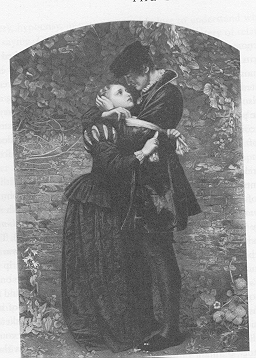
|
A Huguenot exhibits three stereotypical characteristics of love
in mid-nineteen-century art. First, it is emphatically narrative.
Its exquisite lovers exchanging intense gazes are posed to emphasize the
poingnancy of this particular moment on the eve of a massacre which actually
took place in Paris on Aug. 24, 1572, and which promises to end the man's
life.
Secondly, the danger to love comes from without, ...The implied moral
is that love would reign supreme if only the external obstacles of ...could
be surmounted....
Thirdly, there is no pictorial significance attaching to "the between,"
the space between the lovers. It is, in the language of art criticism,
"negative space," incidental to the relationship between the lovers.
from The Culture of Love: Victorians to Moderns.
Left John Millais A Huguenot, on St.
Bartholomew's Day, Refusing to Shield Himself from Danger by Wearing the
Roman Catholic Badge, 1857 |
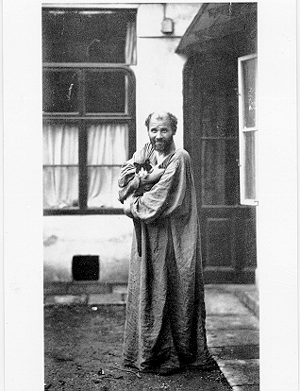 Gustav Klimt
Gustav Klimt
|
|
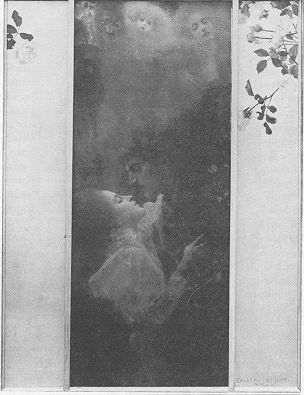
Gustav Klimt, Love, 1985 "Klimt's positive
and deficient love set in a minimally narrative time frame and more exclusively
aesthetic space marks a transition between 19th-century story-telling and
later, more explicit, renderings of encounter" (54) |
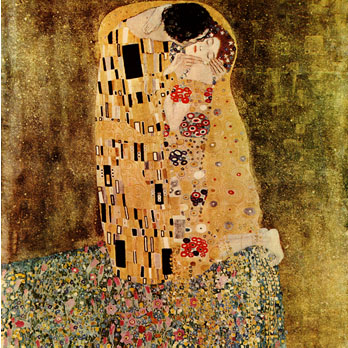
Gustav Klimt, The Kiss, 1908 or 1911
Osterreichische Galerie, Vienna
|
-
Modern Culture: "Araby"
(Joyce); Women in Love, "The Love Song of J. Afred Prufrock" etc.
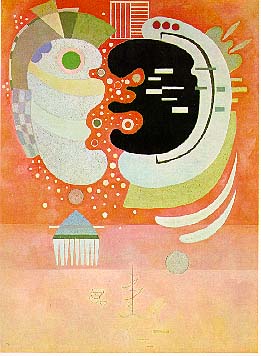 Wassily Kandinsky, Between Two, 1934.
Wassily Kandinsky, Between Two, 1934.
In this painting the protruding curves of the male and
female froms closely approach one another's boundaries, indicating the
powerufl attrative and repulsive forces between them. (57-58) |
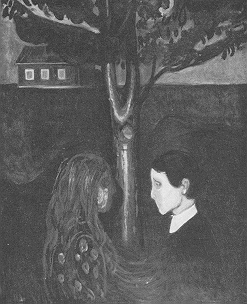 Edward Munch, Eye in Eye, 1894
Edward Munch, Eye in Eye, 1894
contrasts sharply with conventional "love-at-first-sight"
images popular in the 19th-century (p. 55) |
-
Contemporary Examples in Taiwanese
popular culture
|
Romantic love
¡m¯Ú¯×¦©¡n, Sleepless
in Seattle, 㺽¤p»¡, etc.
»¯µúµØ¡A¨¯¾åµX¡q¨ý¹D¡r |
realistic view of love, or satire of Romantic love
½ÞÀY¥Ö¡Ð¡Ð¡q¤õ¿Ní¡r¡B¡q·R¦p§Ñ±¡¤ô¡r(That's
What Love is All about)
Äq¬u
¡q°µ¤Hªº¹D²z¡r
|
Taiwanese
songs on Romantic love--compiled by Julia Hsieh and her group
I. Passiveness, II. Realization
of Romantic Dreams, III. More
understanding after some Twists and Turns, ¬h·tªá©ú
I. Passiveness
1. ¤p¤k¤H
a. ¤ýµá §ÚÄ@·N
§ÚµL¤O§Ü©Ú ¯S§O¬O©]¸Ì
®@~·Q§A¨ìµLªk©I§l
«ë¤£¯à¥ß§Y´Â©p¨g©b¥h
¤jÁnªº§i¶D§A
§ÚÄ@·N¬°§A
§ÚÄ@·N¬°§A §ÚÄ@·N¬°§A
§Ñ°O§Ú©m¦W
´Nºâ¦h¤@¬í °±¯d¦b§AÃh¸Ì
¥¢¥h¥@¬É¤]¤£¥i±¤
§ÚÄ@·N¬°§A §ÚÄ@·N¬°§A
§ÚÄ@·N¬°§A ³Q©ñ³v¤Ñ»Ú
¥un§A¯u¤ß ®³·R»P§Ú¦^À³
§Ú¤°»ò³£Ä@·N
¤°»ò³£Ä@·N ¬°§A
b. ¤ýµá ¬á«ù
§Ú´¿¸g·Q¹L¦b±I¹æªº©]¸Ì
§A²×©ó¦b·N ¦b§Úªº©Ð¶¡¸Ì
§A³¬¤W²´·ú¿Ë§k¤F§Ú
¤£»¡¤@¥yºòºò©ê§Ú¦b§AªºÃh¸Ì
§Ú¬O·R§Aªº §Ú·R§A¨ì©³
¥Í¥²Ä¤@¦¸§Ú©ñ¤U¬á«ù
¥ô¾Ì¦Û¤v¤Û·Q§Ú©M§A
c. ³\¦pªå
§A°Q¹½
§A°Q¹½ ®`§Ú¯«¸g¤¼¤¼
¦æ¬°¤£¦XÅÞ¿è
Åܱo¨S¥X®§
§A°Q¹½ ¨C¦¸J¨¥¶Ã»y
ÂZ¶Ã§Úªº±¡ºü
¶V¨Ó¶V¦Û³¬
¨C¦¸·í§AÂà¨Â÷¥h
§Ú´N¶}©l·P¨ì¤£¦w¥þ
·R±¡Åý¤HÅÜ°Q¹½
d. ³\¦pªå
¥bººq
¦³®ÉÔ·Q§â¥Í©R¤@¥bµ¹§A
§Ú«K¤£¥Î©Ó¨ü§Aªº³u¥h
¦³®ÉÔ·ÓµÛÃè¤l³£¤£¬Û«H
§A¦ó®É¦¨¬°§Úªº°ß¤@
§Ú¥u·Q¦¨¬°§Aªº¤@¥b
Â÷¤£¶}§A¥ô¦ó¤@Ó©]±ß
§Ú¬O³oººqªº¥t¤@¥b
e. »¯µúµØ
--³Ì®öº©ªº¨Æ
2. «è¤k±ó°ü
a. ñK¬ü¶³--µ¥·Rªº¤k¤H
b. °ó®R--§A«ç»ò¥i¥H¤£·R,°ø¨D
c. ¨¯¾åµX--¨ý¹D
3. ¦º¤]¤£©ñ¤â
a. §õª³ §Ú¨ÌµM¬O§Aªº±¡¤H
........§Aªº¤ßÁ`¬Oµ½ÅÜ
·R¤W§A©l²×¦MÀI........
........§Ú¨ÌµM¬O§Aªº±¡¤H
§Ú¨ÌµM·R§A³Ì²`
§O¦bºò³¬§Aªº®B ¤£ú¤£¯º¤]¤£°Ý.........
b. §õª³ ¤£¦´
......§A©M§Ú ¤S¨ì¸Ó¤À¤âªº®ÉÔ
¤Ñ·NÃø¨D ¤H¤ßÃø¯d
¯P§k¼ö¾Ö±Ð¶Â©]¤£n¨«......
4. Woman as an object
¤ýµá ´Ñ¤l
§Ú¹³¬O¤@Áû´Ñ
¶i°h¥þ¥Ñ§A¨M©w
§Ú¤£¬O§A²´¤¤°ß¤@±N»â
«o¬O¤£°_²´ªº¤p§L
§Ú¹³¬O¤@Áû´Ñ
¨Ó¥h¥þ¤£¥Ñ¦Û¤v
Á|¤â¤£¦^§A±q¤£´¿µS¿Ý
§Ú«o¨ü±±¦b§A¤â¸Ì
II. Realization of Romantic
Dreams
1. ©PµØ°·/§õ«×--©ú¤Ñ§Ún¶ùµ¹§A°Õ
2. »¯µúµØ--³Ì®öº©ªº¨Æ
3. Àu«È§õªLvs.±i²MªÚ--¥X¶ù
§Ú¥Î¤@¥Í¤@¥@ªº¤ß´«§A¤@¥Í¤@¥@ªº±¡
¤]³\¬O±J©R¤]³\¬Oª`©w
§Ú¯uªº§Æ±æ¯à¦hÂI¦n¹B
§Ú¥Î¤@¥Í¤@¥@ªº¤ß´«§A¤@¥Í¤@¥@ªº±¡
²o§Aªº¤â..............(ps.³o¤]¦³ÂIpassiveªº¨ý¹D)
III. More
understanding after some Twists and Turns, ¬h·tªá©ú
´¿¼y·ì ¬Û¨£
¦³¨S¦³¥i¯à §Ú̦A¬Û·R¤@¦¸
À´¤£À´ §Ú·Q§ÚÀ´
¬Q¤Ñ¤wÄÝ©ó¬Q¤Ñ
ÁöµM§Ú̪º·R±¡
³Ì«á¨S¦³Åܦ¨¬üÄR¯«¸Ü
´N¹³¨ä¥L·R±¡
ÁÂÁ§A §AÅý§ÚÀ´±o¤F·R |
References:
The Nature of Love 3: The Modern World.
Irving Singer. Chicago: U of Chicago P, 1987.
Romantic Passion: A Universal Experience?
Ed. William Jankowiak. NY: Columbia UP, 1995
The Humanities: Cultural Roots and Continuities 4th ed. Vol
II. Mary Witt, et al. pp. 298-99
 Romantic
Passion
Romantic
Passion


